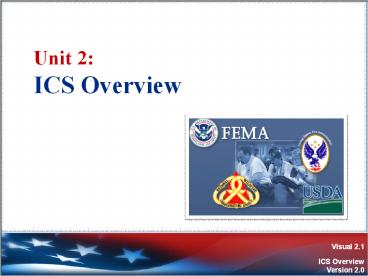Unit 2: ICS Overview - PowerPoint PPT Presentation
1 / 16
Title:
Unit 2: ICS Overview
Description:
Title: ICS200 Author: Sharon Last modified by: Jessica Golobish Created Date: 12/3/2004 5:53:15 PM Document presentation format: On-screen Show Other titles – PowerPoint PPT presentation
Number of Views:109
Avg rating:3.0/5.0
Title: Unit 2: ICS Overview
1
Unit 2 ICS Overview
2
Unit Objectives
- Identify three purposes of the Incident Command
System (ICS). - Identify requirements to use ICS.
3
What Is an Incident?
- An incident is . . .
- . . . an occurrence or event, natural or
manmade, that requires a response to protect life
or property.
4
What Is ICS?
- The Incident Command System
- Is a standardized, on-scene, all-hazard incident
management concept. - Allows its users to adopt an integrated
organizational structure to match the
complexities and demands of single or multiple
incidents without being hindered by
jurisdictional boundaries.
5
ICS Purposes
- Using management best practices, ICS helps to
ensure - The safety of responders and others.
- The achievement of tactical objectives.
- The efficient use of resources.
6
History of ICS
- Weaknesses in incident management were due to
- Lack of accountability.
- Poor communication.
- Lack of a planning process.
- Overloaded Incident Commanders.
- No method to integrate interagency requirements.
- The identification of these areas of management
weakness resulted in the development of ICS.
7
Knowledge Review (1 of 2)
- Instructions Decide if the statement is TRUE or
FALSE.
ICS could be used to manage a training
conference, charity fundraising event, or
emergency response and recovery.
8
Knowledge Review (2 of 2)
- Instructions Decide if the statement is TRUE or
FALSE.
The study of previous incident responses found
that failures likely resulted from a lack of
resources.
9
Homeland Security Presidential Directives (HSPDs)
HSPD-5
- Management of Domestic Incidents
HSPD-8
National Preparedness
Mandates
National Incident Management System (NIMS)
10
NIMS
- What ? . . . NIMS provides a consistent
nationwide template . . . - Who? . . . to enable Federal, State, tribal, and
local governments, the private sector, and
nongovernmental organizations to work together .
. . - How? . . . to prepare for, prevent, respond to,
recover from, and mitigate the effects of
incidents regardless of cause, size, location, or
complexity . . . - Why? . . . in order to reduce the loss of life
and property, and harm to the environment.
11
NIMS Components ICS
Preparedness
Communications and Information Management
Incident Command System
Resource Management
Multiagency Coordination Systems
- Command and Management
Ongoing Management andMaintenance
Public Information
12
ICS Benefits
- ICS
- Meets the needs of incidents of any kind or size.
- Allows personnel from a variety of agencies to
meld rapidly into a common management structure. - Provides logistical and administrative support to
operational staff. - Is cost effective by avoiding duplication of
efforts.
13
Activity Management Challenges (1 of 2)
- Instructions
- Working as a team, review the scenario presented
on the next visual. - Identify the top three challenges for managing
this incident. Write these challenges on chart
paper. - Using what you have learned so far, describe how
ICS could be used to address these challenges. - Select a spokesperson. Be prepared to present in
5 minutes.
14
Activity Management Challenges (2 of 2)
- Scenario An unexpected flash flood has struck a
small community. As a result - Homes, schools, and the business district have
been evacuated. - Critical infrastructure has been damaged
including contamination of the water supply,
downed power lines, and damaged roads. - Perimeter control and security in the business
district are needed. - Mutual aid and assistance is arriving from
several surrounding communities.
15
Summary (1 of 2)
- Instructions Answer the questions below.
- What are three purposes of ICS?
- What are the requirements to use ICS?
16
Summary (2 of 2)
- ICS
- Is a standardized management tool for meeting the
demands of small or large emergency or
nonemergency situations. - Represents "best practices," and has become the
standard for emergency management across the
country. - May be used for planned events, natural
disasters, and acts of terrorism. - Is a key feature of NIMS.































